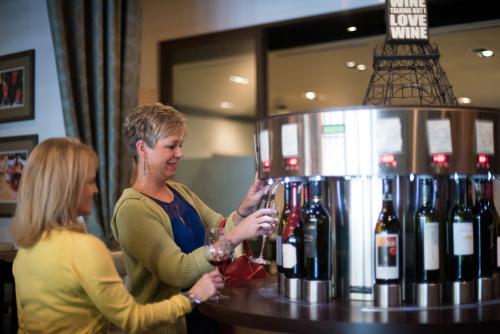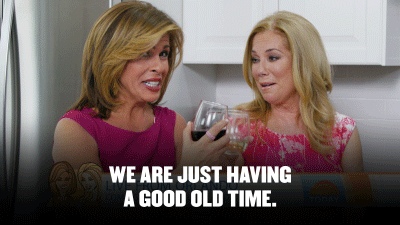The server approaches with the bottle. He starts talking about notes and tannins and an earthy flavor. As in, like, dirt? He opens the bottle and pours a splash in your glass and looks at you. He's waiting for you to do something. In confusion and panic, you stand up and start dancing. You and your friend do a terrible impression of Kathie Lee and Hoda.

Judging by the server's expression, that wasn't the right response.
Apparently, there are rules to drinking wine beyond just opening the fridge and putting your mouth directly under the Bota box. You can Google those rules yourself, because we've made our own list of tips. They may or may not be accepted by your coworker who "has a French friend," but they'll at least help you pass by on your next night out.
Step 1: How To Order Wine

Forget the old rules about pairing whites with fish, reds with steak, blah blah blah. Confidently order whichever wine you like with whichever food you like. (Bon Appetit backs us up on this.) Most decide by full vs. light-bodied, dry vs. sweet and sometimes, by the region the grapes came from.
Full vs. Light-Bodied
A full-bodied wine is richer, more complex. It is full and round in your mouth. It's that 18th-century novel you read in college and actually liked. Lighter-bodied wines have less of a punch. They are light on the tongue, they are that little dress you wear in the summer.
Sweet vs. Dry
To simplify it, the difference between sweet and dry depends on the amount of sugar in the wine (there are more things involved like "tannins," but who needs 'em). You'll find you naturally prefer one or the other, but don't rule out a wine just because you "can't do sweet." A glass of good quality wine can surprise you. Sweet wines: Moscato, Riesling (whites). Lambrusco, Pinot Noir (reds).
Dry wines: Chardonnay, Sauvignon Blanc (whites). Merlot, Cabernet, Malbec (reds).
Region and Method
Where and how the wine is made does make a difference. California and Italy are good standbys, but CNN says Georgia (the country, not our beloved state), Slovenia, Portugal, the Finger Lakes in New York, and Franschhoek in South Africa are up-and-coming regions. As far as method goes, many wineries now produce biodynamic wines, which are organic and sustainable. When in doubt, ask your waiter for a recommendation. There is no shame in this - they're paid to know what they're talking about.

Insider's Tip: We recommend stopping by E. 48th Street Market for both wine and complementary wine essentials. The selection is great, the staff is friendly and knowledgeable, and the cheese counter will make you swoon.
Step 2: How To Taste Wine

When the server opens your bottle, she will pour a taste for one person before serving to the table. If that person is you, you could swirl your wine in your glass, sniff it, swish it around your mouth, spit it out. Or you could just taste it. Tell your server whether or not you like the wine and then move on with your life. Order the scampi. Call your mom back. Let the dog out. Curse the dog when it wakes you up at 3 a.m. to go out again.
Insider's Tip: If you want to skip the formality and try more than one or two wines, head to Vino Venue in Dunwoody. With their futuristic nomadic machines, you can serve yourself as many tastes or glasses of wine as you like (even the ones you can't afford by the bottle).

Step 3: How To Drink Wine
If you plan to drink more than one glass or bottle of wine, the general rule is to start with whites and make your way up to reds. Hold your glass near the base between your thumb, forefinger and middle finger. Swirl it around now and then if you like. You're a fancy wine drinker now!
Well, there you have it. Your coworker and "Pierre" may be scoffing in between their trills, but the truth is that few people really know what they're doing when it comes to drinking wine. If you'd like to really go pro, try a class with Atlanta Wine School. But if you're not looking to be a sommelier, just relax and be yourself. Or at least the version of yourself that doesn't do that terrible Kathie Lee and Hoda impression.

